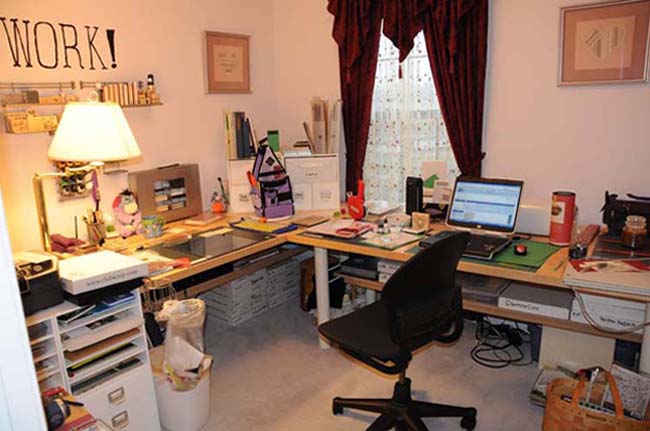Monday, May 9, 2011
PTotD
Tip #129. Those Swatches that are available in the Color/Styles/Swatches panel by default are a fast and easy way to select a color. The cursor will turn into an eyedropper when it is over the swatches panel and a fist will let you know that you have successfully clicked to grab a color. Glance over at the background/foreground icon to make sure that you got the right one. Hover your cursor over a swatch to see what it is named. If you right or option-click in the panel, you can save a color you like as a swatch. Make sure you give it a descriptive name. You use the Preset Manager to save your swatches as an .aco file. They aren’t saved unless they are in a file you can back up. Photoshop will remember them if you close down the application, but that doesn’t mean they are saved!
Sunday, May 8, 2011
PTotD
Tip# 128. Gradients are a great way to put a little more interest into a background. Give this a try. Open a document and put in a ho-hum kind of background. Create a new layer above it. Select black or some dark color from your swatches and then select the Gradient tool. The Keyboard shortcut is the letter G. You might get the paint bucket first, but you want the Gradient tool. Then go to the options bar and select from the second drop-down from the left to set the kind of gradient. The first choice is from a foreground color to white, and the second one is from the foreground color to transparent. You want to use the transparent option. Then look at the icons.to the right of that. The first one is a horizontal gradient, the second is a radial gradient, the third is Angle, the next is reflected and the last one is diamond. If you hover your cursor over the icons, you’ll see a name pop up. The one you want for this is the radial gradient. Next, click inside your layout somewhere around 10:00 and drag down towards 4:30. A line will appear, indicating the direction of the gradient. When you release the drag, a layer of color will appear that fades from your start color and start point down to transparent at the end point. Whee!!! If you want it to be darker or lighter, select a different color, change the opacity of the layer, or make the drag line start and end in different places.
Saturday, May 7, 2011
Photoshop Tip of the Day
Tip # 127. When making a tricky selection, there isn’t anything wrong with making adjustments to your image to make the selection tools work better. Your goal is a good selection. You can add an adjustment layer, and tweak the contrast to be incredibly wrong, for example. Just ditch the adjustment layer after the selection is made. Or, if you are using Smart Objects, you can revert back to the original. Wow. What a concept.
Friday, May 6, 2011
PTotD
Tip # 126. A Smart Object can be defined as an object, which may be composed of multiple layers/objects or a single layer/object, which remembers what it used to be, so the changes you make are not permanent and can be reversed. A smart object has a marker in the lower right corner of the icon in the layers panel to indicate that it is a Smart Object. The marker looks like three images, with one black and two white. You can create Smart Objects several ways. Right or control-click on the layer in the layers panel and select Convert to Smart Object. Or you can go to Layer | Smart Object | Convert to smart object. You can control or right-click on the object in your layout and select convert to Smart Object. You can even convert for a smart filter through the Filter menu, which will create a Smart Object. When you drag and drop an image from MiniBridge in CS5, it will import as a Smart Object. It will have bounding box that includes an X through the center. Hit Enter, and it will be a smart object. Smart Objects do have a few limitations, but in general, they are useful, because you retain the ability to undo changes, even after saving and closing the file.
PTotD
Tip # 125. Ever open a file, make a few changes and immediately hate them? You want to go back to the freshly opened file and start over again, but you don’t want to undo, use the History, or close without saving changes and then open the file again. Just go to the file menu and select revert. Your file will go back to the way it was when you first opened it.
Wednesday, May 4, 2011
PTotD
Tip #124. As usual, Photoshop has more than one way to get to the same settings for the Brush tool. The keyboard shortcut for the Brush tool is the letter B. Have you noticed that many of the keyboard shortcuts for the tools are the bottom row of letter keys? Ahem. In the options bar, from left to right, you’ll see first an icon of the tool you have chosen. There will be a dropdown arrow next to that tool icon. If there are presets for that tool available, they will be listed. Don’t be confused by the word ‘presets’. There are other brush presets that you’ll need to know more about. Next to that, will be an icon of the selected brush and a dropdown arrow. If you choose that, you’ll get to a pared-down panel for selecting brushes and changing the size and hardness of the brush. The number in the pictures you see will let you know the size of the brush. It’s the larger of width or height in pixels. Next to that is an icon of three brushes in a jar. Clicking on the icon will open up the brushes panel, which includes tabs for brush presets, brush settings, and clone source. Now that you know where to go to change brush settings, it’s time to play. See ya later!
Tuesday, May 3, 2011
PTotD
Tip #123. Those blobby/spiky shapes for the brush tool are great when you want to apply an action, but softly, gradually. Say I want to erase something, so I can see through it to the layer below, but I want the top layer to remain in ghost-like fashion. Instead of doing a selection with a feathered edge and playing with blend modes, I can use a soft brush to erase what I don’t want. And with a soft, blobby brush, I can work gradually. If you are trying to do things like this with a mouse, you won’t have pressure sensitivity. If you have a tablet, you are good to go.
Monday, May 2, 2011
PTotD
Tip #122. The Eyedropper tool you use to take a color sample can take a sample of a single pixel, or sample a set of pixels. It takes the average color in your sample, so a larger or smaller sample can make a big difference. You can make the sample size from one pixel, up to 101 pixels by 101 pixels. When you change the setting for the eyedropper tool in the tool bar by changing the sample size, it becomes the setting for the eyedropper in the color picker. Photoshop’s default setting for the eyedropper is for a single pixel.
Sunday, May 1, 2011
PTotD
Tip #121. Keep your screen clean. Not just ‘I dusted it off a while ago.’ But absolutely clean. Never touch your screen. Point at it, point to it, but don’t let your fingers touch your screen. The last thing you want to do is to adjust for a shadow, only to realize it was a smear on your screen.
Subscribe to:
Comments (Atom)




